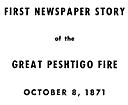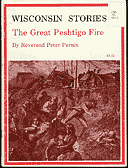


 |
  |
|
|
|||
 The Marinette and Peshtigo Eagle |
|
 The Great Peshtigo Fire: An Eyewitness Account |
|
The great fires that have recently spread, with such disastrous results, over our whole northern frontier, from the Rocky Mountains to Central New York and Pennsylvania, must be regarded as the effect of meteorological causes. Unusual dryness has prevaded the atmosphere during the past two months; the amount of rain-fall has been very considerably less than the average and the amount of evaporation considerably more. (Rain at Milwaukee in September; Maximum (1841) 7.02 inches; mean of twenty-nine years 2.88; minimum (1871) 0.60.) Very little rain has fallen upon most of this extended region since August. Winds from a southwesterly direction, blowing often with great force and for several days continuously, bring to the great prairie region of the West this excessive dryness. Their prevalence is often shown by the direction toward which the trees lean; they absorb moisture from every source, making everything of a combustible nature still more combustible. The soil itself becomes desiccated to a considerable depth. Pine lumber, of which houses, barns, fences, &c., are made, becomes excessively inflammable. The weeds and grass of the prairies and stacks of hay and grain are deprived of all moisture, and partake of the nature of tinder. When these winds are blowing, a small spark is sufficient to kindle a great fire; the camp fire, the wad from a gun, a spark from a locomotive, even the remnant of a cigar, or the ashes from a pipe, may start a fire that will spread over a county. A stroke of lightning has; doubtless been the origin of many a prairie fire. The Indians are said to have purposely set them on fire to rout the deer and other game. The violent wind hastens to spread the flame over a constantly widening space, until large districts are laid waste by the "destroying element." It is familiarly known that these fires have annually spread over the great prairie region of the Mississippi Valley since their first exploration. Prairie fires are no new thing. Of course they vary in extent from year to year, according to the varying dryness of the seasons and other meteorological causes. A smoky atmosphere in autumn has been the common experience every year; and this smokiness has its origin in prairie fires at the West. The fire once started in the dry grass and weeds of the prairie cannot be extinguished; it must take its own course, gradually widening as it moves forward, until it presents a front of a hundred miles or more: and the flames, often reaching a great height, are blown forward, setting fire to places many rods ahead. These fires do not kill the roots of the prairie grass, which springs up fresh from the blackened soil when its proper season returns; but the germs of other plants, including all forest trees, are destroyed. When these fires reach the borders of the forest region the trees are attacked, and many of them destroyed; others are more or less injured. The young shoots are killed; the roots beneath the soil, and in many cases even the soil itself is consumed. It is when the southwest wind is high, and the atmosphere dry, and when, from long absence of rain, the vegetation is also dry, that we are to look for these great prairie fires. We thus have before us the true theory of the origin of the prairies: they are clearly due to the dryness of the climate in autumn and the consequent fires. Their existence is not due to the effect of dryness of climate upon the growth of trees themselves, for, when protected from fires, trees are found to flourish in the prairie region. It is by fire (induced by dryness) that the trees are destroyed or prevented from growing. These conditions of climate, the autumnal dryness and the prevalence of southwest winds, have existed for ages, and hence the normal condition of the great western plains is that of prairie; and so long as these causes exist, this region must always remain in this condition, unless changed by ingenious and persistently-applied devices of art. The normal condition of other regions is that of forest growth. When old fields are abandoned within these forest regions, as in Virginia, &c., or wherever lakes have been drained, a growth of trees immediately takes possession of the soil. In a few years the forests have resumed their possession. Within the prairie region the soil is equally well adapted to the growth of trees, and, by continued effort in the prevention of fires, they may soon be made to cover the land with their grateful shade, their beauty, and their usefulness; but should these efforts be discontinued for a few years, the dry weather, the high winds and the accidental fires will surely do their appointed work, and the prairie grass will resume its possession of the ground. The normal condition of prairie will again be established. The northern boundary of the region of prairie forms a line which varies from year to year as the seasons vary. A continued succession of dry seasons encourages great fires, that penetrate the forest border and extend the area of the prairie; while a similar succession of wet seasons may allow a growth of trees to spread far within the proper boundaries of the prairie. A constant struggle is thus maintained between the two conditions of forest and prairie, alternating within certain limits, and changing the position of the dividing line. It is here that we find the "openings," or scattered trees, chiefly of the burr-oak, (Quercus macrocarpa.) which give so much park-like beauty to the landscape. The work of extending the prairie border was exhibited in the autumn of l871 upon the grandest scale. Fires have swept more or less completely along the whole northern frontier, from the Rocky Mountains through Dakota, Minnesota, Wisconsin, and Michigan, and even into New York and Pennsylvania. Within the past two or three decades this region has been occupied and "improved;" farms have been opened, mills built, especially throughout the "lumber region," or places where the stately white pine (Pinus strobus) predominates. Villages, large towns, and even great cities have sprung up along this prairie border-line with a rapidity truly wonderful. And now it is found that these natural, ever-recurring meteorological causes which have for so many ages prevented the growth of forest trees, are equally operative in preventing the building of houses, towns, and cities. Not only has the wild prairie region been swept by fires of 1871 but thousands of square miles of forests have been destroyed. Many farms, with their houses, barns, stacks of hay and grain, miles of fences, &c., have been destroyed. At the same time a number of towns and a large part of the city of Chicago was consumed, involving the loss of many thousand human lives. The ground upon which these improvements were made has been reduced to the normal condition of prairie. It becomes apparent, then, that if we wish to occupy and improve this prairie region, to cover it with villages, towns and cities, to cultivate its rich and productive soil, we must contend against this natural law, which constantly and surely tends to assert its power to reduce everything to its former normal condition. To do this will require more than individual effort; only united and enforced, or in other words governmental effort can afford hope of success. The precautions necessary to resist this destruction of property are of the simplest kind, being only such as are necessary to prevent the occurrence and spread of fire. This involves not only watchfulness, but the disuse, as far as possible, of all combustible materials. The watchfulness should extend not only to our own premises, but to prevent the carelessness and criminality of others, which can only be done by public authority. The use of kerosene in all its forms should be prohibited; no locomotive should be allowed to move without adequate means to prevent the emission of sparks from the smokestack, and no fences of wood should be built. If the farmers of France, Germany, &c., can do without fences, certainly we can do the same, and thus save not only this food for the fires, but one-half of the aggregate capital required in the conduct of our agriculture! A thousand other measures, needless here to mention, should be adopted and enforced, looking to the same end. It is announced that some farmers who have "lost their all" by these fires have become disheartened and discouraged and will entirely abandon their possessions. If this is done now, while everything is fresh and new, while the soil retains its virgin richness, what may we expect in after years? Gradually, but surely, the whole country will be reduced (as have been the once fertile plains of the East) to the condition of a desert. It is true this may be in the distant future, but it is nevertheless our duty to prevent this result, so far as it is within our power. If fences could be dispensed with, and if our houses could be constructed of materials other than wood, the very great destruction of our forests, now going on with such fearful rapidity, would be checked. It is estimated that fifty years will suffice to consume the pine lumber of Wisconsin and Michigan, the chief present sources of supply; the time therefore is close at hand when the forests will no longer supply the lumber used in temporary construction, erected only to increase the danger of great public calamities by fire! Should the present policy be continued, the destruction of a large share of the newly-built railroad stations in the prairie-region of the West will surely come; they are built in opposition to the law of the land, a law that sooner or later must be enforced. A dry season, a strong wind, and an accidental fire, whenever they occur together, will do the work. If these views be correct, it is apparent that the precautions against these greater calamities are most needed at the southwest part of the town or city: here is always the place of greatest safety, and here should be erected buildings for the preservation of the most precious records and works of arts, which, if lost, cannot be restored. Had the fire of Chicago originated at the north or east side of the city, the barn in which the kerosene lamp was kicked over alone would have been burned. The question is often asked whether the great fires of the Northwest, during the months of September, October, and November, 1871, and especially the one which leveled to the ground a large share of the city of Chicago, had any decided effect upon the weather, either by creating or modifying currents of air or by causing a fall of rain. It was reported by telegram to England, and there published, "that this fire was chiefly checked on the third or fourth days by the heavy and continuous down-pour of rain, which it is conjectured was partly due to the great atmospheric disturbances which such an extensive fire would cause, especially when we are told that the season just previous to the outbreak of the fire had been particularly dry." This was said to afford an additional example from which to judge of the truth of the so much disputed assertion that extensive fires are almost invariably followed by heavy down-pours of rain which have been caused by them. A very little attention to the facts exhibited by the great fire will show that no such down-pours occurred, and that the fire was checked, not by rain, but for want of other combustible material in the direction toward which the flames were driven by the wind. The fire commenced at 9 1/2 p.m. of Sunday, October 8, and continued during that night and most of the succeeding day. By 2 a.m. of the 9th, it had reached the court-house and the Sherman House, and was consuming the most valuable portions of the city. Twelve hours later it was ravishing Lincoln Park, in the north part of the city. The last house consumed (Dr. Foster's) was in flames at 10 p.m. Commencing at a point in the southwest part of the city, the fire moved rapidly to the northeastward, and only ceased when it had reached the extreme north part of the city, or the shore of Lake Michigan on the east. After this time there was but little spread of the flames, though the burning buildings were not yet entirely consumed. During all this time, twenty-four hours of continuous conflagration upon the largest scale, no rain was seen to fall, nor did any rain fall until 4 o'clock the next morning; and this was not a very considerable "downpour," but only a gentle rain, that extended over a large district of country, differing in no respect from the usual rains. The quantity, as reported by meteorological observers at various points, was only a few hundredths of an inch. It was not until four days afterward (14th) that anything like a heavy rain occurred. It is therefore quite certain that this case cannot be referred to as an example of the production of rain by a great fire. Must we therefore conclude that fires do not produce rain, and that Professor Espy was mistaken in his theory on that subject? By consulting his reports, it will be found that he only claimed that fires would produce rain under favorable circumstances of high dew-point and a calm atmosphere. (Fourth Report, 1857, p. 29) Both these important conditions were wanting at Chicago, where the air was almost entirely destitute of moisture, and the wind was blowing a gale. To produce rain, the air must ascend until it becomes cool enough to condense the moisture, which then falls in the form of rain. But here the heated air could not ascend very far, being forced off in nearly a horizontal direction by the great force of the wind. The case therefore neither confirms nor disproves the Espian theory, and we may still believe the well authenticated cases where, under favorable circumstances of very moist air, and absence of wind, rain has been produced by large fires. At some localities where fires occurred of considerable extent, rain was observed to fall during their progress; but so far as is known, these were general rains, extending equally over the country, and not produced or apparently affected by the fire. Had these great fires occurred during a calm, doubtless many of the phenomena described in Espy's theory--the ascending current, the in-blowing air from all directions, the cloud formation above, and possibly even rain, may have been produced; but all these were prevented or very materially modified, by the lack of moisture and the great force of the southeast gale. The effect of these great fires upon the currents of air was also materially modified by the great force and velocity of the southwest gale. While it is undoubtly true, as stated by Espy and others, that the increased temperature of the air causes it to rise, and thus produce an inflow of the surrounding atmosphere from all sides, it is manifest that the gale prevents an inflow from the front and increases it in the rear. Different observers represent the wind as sweeping along at a fearful rate, increasing as the fire progressed. While some report a whirling motion, others say the motion was direct. As the flames arose above the tops of the houses, or of the forests, they were forced forward by the fierce gale. Fire-brands were carried a great distance; and even roofs of houses are said to have been lifted up and precipitated upon adjoining buildings. It was, at times, difficult for a strong man to resist the force of the wind. The approach of the fire is represented as very rapid, and accompanied by unusual sounds, increased to that of Niagara. Piles of lumber were blown away, chimneys thrown down, and sand and ashes were swept along like drifting snow. Under these conditions, the fires of course spread with the most fearful rapidity in the direction toward which the wind was blowing, its velocity being such as to carry the hot air, the flames, and the burning brands directly forward. The predominant force of the southwest wind was sufficient to overcome any tendency toward local currents. But fluctuations in the direction of the wind always occur, and give rise to different statements as to its direction. (But there can be no excuse for the blunder of an illustrated New York paper, by which the flames are represented as being carried in a direction exactly contrary to the fact.) The draught of air upon the two sides of this rapidly progressing stream of fire, near the ground, was often very considerable. The lateral spread of the flames was against this draught, and of course was comparatively slow in its progress. Masses of flames were blown forward, and are described as "balls of fire that were observed to fall like meteors in different parts of the town, igniting whatever they came in contact with." Another account says "that the fire came from the air above, more than from the earth. It swept along in detached clouds borne with a tornado-like fury. The clouds of fire would be swept along in waving masses of different sizes. A man describes one of these clouds as of 40 feet in size each way. Whatever he saw it touch, the object, tree or house, wilted directly down. These clouds of fire usually touched the tops of the tallest houses first, when the building would burn down as if saturated with kerosene. It seems as if the air was charged with clouds of fire." The intense heat and great rapidity with which houses were consumed, are among the most wonderful facts connected with these fires, and have given occasion for the suggestion of several causes, both natural and supernatural. It is believed, however, that a slight consideration of the effects of the blow-pipe and of the blast-furnace will sufficiently explain all the observed facts. The strong wind, by constantly adding oxygen to the flames, increased their magnitude and the intensity of the heat. The telegraph wires indicated no unusual disturbance of the electrical condition of the atmosphere, and the rapid production of flame, under the fierce blast of wind, will account for the intensity of the heat, without resorting to the absurdity of the decomposition of the atmospheric air. We may therefore conclude that these fires were rendered possible, and owe their intensity and magnitude to meteorological causes, and that they neither confirm nor disprove Professor Espy's theory of storms and the artificial production of rain. |